1993 BUICK REGAL ESP
[x] Cancel search: ESPPage 145 of 308
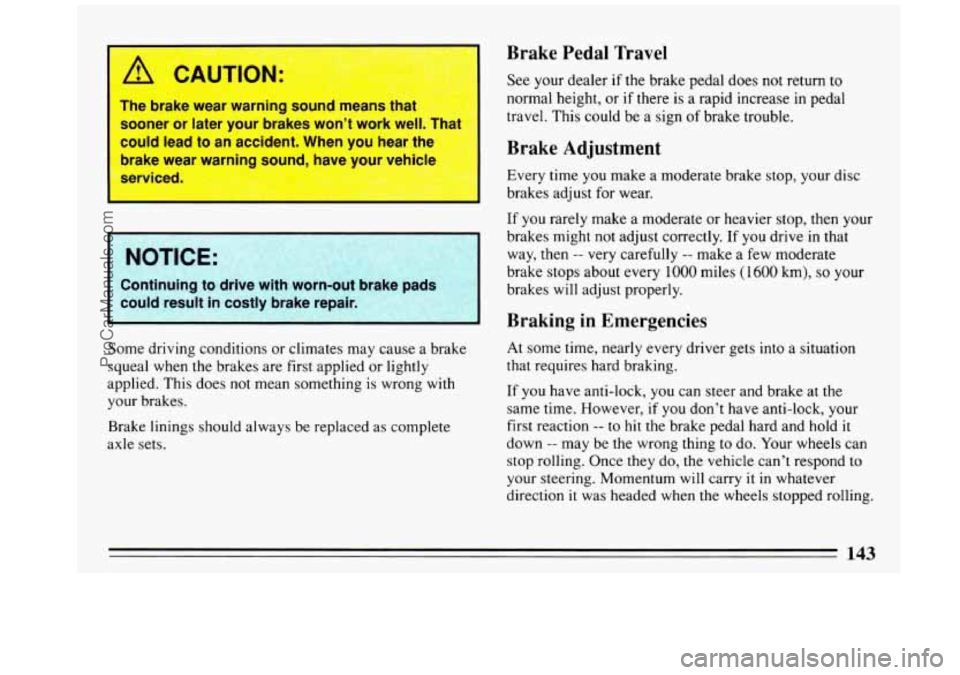
A LAUTION:
The brake wear warning sound means that
sooner or later your brakes won’t work well. Thal
could lead to an accident. When you hear the
brake wear warning sound, have your vehicle
serviced
NOTICE:
Continuing to drive with worn-out ‘-ake pat-
could result in costly brake repair
Some driving conditions or climates may cause a brake
squeal when the brakes are first applied or lightly
applied. This does
not mean something is wrong with
your brakes.
Brake linings should always be replaced as complete
axle sets.
Brake Pedal Travel
See your dealer if the brake pedal does not return to
normal height, or if there is a rapid increase in pedal
travel. This could be a sign
of brake trouble.
Brake Adjustment
Every time you make a moderate brake stop, your disc
brakes adjust for wear.
If you rarely make a moderate or heavier stop, then your
brakes might not adjust correctly.
If you drive in that
way, then
-- very carefully -- make a few moderate
brake stops about every
1000 miles (1600 km), so your
brakes will adjust properly.
Braking in Emergencies
At some time, nearly every driver gets into a situation
that requires hard braking.
If you have anti-lock, you can steer and brake at the
same time. However, if
you don’t have anti-lock, your
first reaction
-- to hit the brake pedal hard and hold it
down
-- may be the wrong thing to do. Your wheels can
stop rolling. Once
they do, the vehicle can’t respond to
your steering. Momentum will carry it in whatever
direction it was headed when the wheels stopped rolling.
ProCarManuals.com
Page 149 of 308
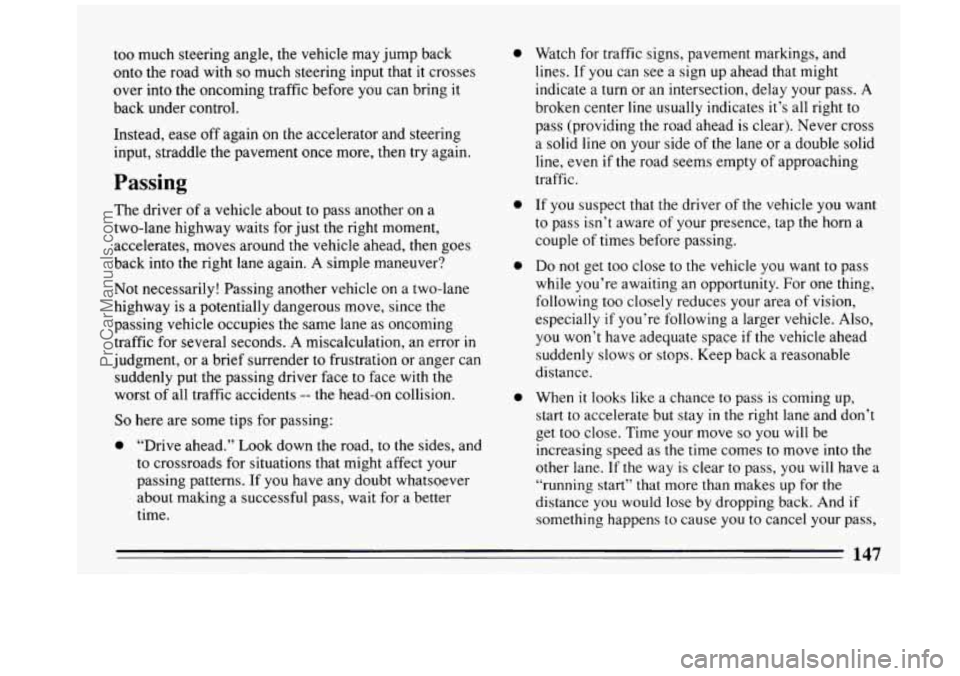
too much steering angle, the vehicle may jump back
onto the road with
so much steering input that it crosses
over into the oncoming traffic before you can bring it
back under control.
Instead, ease
off again on the accelerator and steering
input, straddle the pavement once more, then try again.
Passing
The driver of a vehicle about to pass another on a
two-lane highway waits for just the right moment,
accelerates, moves around the vehicle ahead, then goes
back into the right lane again.
A simple maneuver?
Not necessarily! Passing another vehicle on a two-lane
highway
is a potentially dangerous move, since the
passing vehicle occupies the same lane as oncoming
traffic for several seconds. A miscalculation, an error
in
judgment, or a brief surrender to frustration or anger can
suddenly put the passing driver face to face with
the
worst of all traffic accidents -- the head-on collision.
So here are some tips for passing:
0 “Drive ahead.” Look down the road, to the sides, and
to crossroads for situations that might affect your
passing patterns. If you have any doubt whatsoever
about making a successful pass, wait for a better
time.
0 Watch for traffic signs, pavement markings, and
lines. If you can see a sign up ahead that might
indicate
a turn or an intersection, delay your pass. A
broken center line usually indicates it’s all right to
pass (providing the road‘ahead is clear). Never cross
a solid line on your side of the lane or a double solid
line, even
if the road seems empty of approaching
traffic.
0 If you suspect that the driver of the vehicle you want
to pass isn’t aware of your presence, tap the horn a
couple of times before passing.
0 Do not get too close to the vehicle you want to pass
while you’re awaiting an opportunity. For one thing,
following
too closely reduces your area of vision,
especially
if you’re following a larger vehicle. Also,
you won’t have adequate space
if the vehicle ahead
suddenly slows or stops. Keep back a reasonable
distance.
0 When it looks like a chance to pass is coming up,
start to accelerate but stay in
the right lane and don’t
get too close. Time your move
so you will be
increasing speed as the time comes to move into the
other lane.
If the way is clear to pass, you will have a
“running start” that more than makes up for the
distance you would lose by dropping back. And
if
something happens to cause you to cancel your pass,
147
ProCarManuals.com
Page 150 of 308
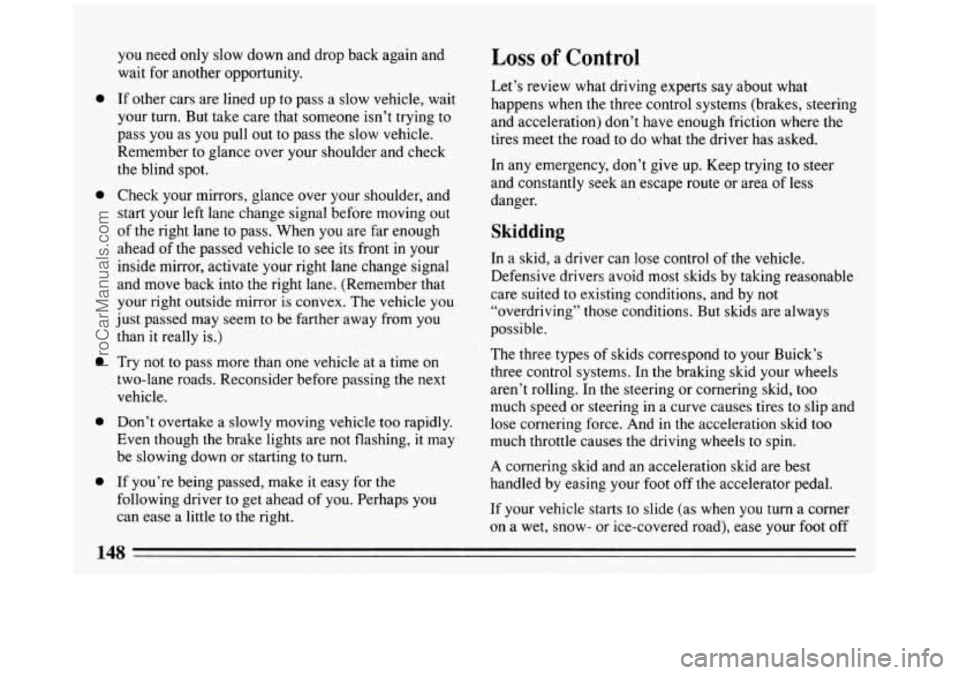
0
0
0
0
0
you need only slow down and drop back again and
wait
for another opportunity.
If other cars are lined up to pass a slow vehicle, wait
your turn. But take care that someone isn’t trying to
pass you as you pull out to pass the slow vehicle.
Remember to glance over your shoulder and check
the blind spot.
Check your mirrors, glance over your shoulder, and
start your left lane change signal before moving out
of the right lane to pass. When you are far enough
ahead of the passed vehicle to see its front
in your
inside mirror, activate your right lane change signal
and move back into the right lane. (Remember that
your right outside
mirror is convex. The vehicle you
just passed may seem to be farther away from
you
than it really is.)
Try not to pass more than one vehicle at a time
on
two-lane roads. Reconsider before passing the next
vehicle.
Don’t overtake a slowly moving vehicle too rapidly.
Even though
the brake lights are not flashing, it may
be slowing down or starting to turn.
If you’re being passed, make it easy for the
following driver to get ahead of you. Perhaps
you
can ease a little to the right.
Loss of Control
Let’s review what driving experts say about what
happens when the three control systems (brakes, steering
and acceleration) don’t have enough friction where the
tires meet the road to do what the driver has asked.
In any emergency, don’t give up. Keep trying
to steer
and constantly seek an escape route or area of less
danger.
Skidding
In a skid, a driver can lose control of the vehicle.
Defensive drivers avoid most skids by taking reasonable
care suited to existing conditions, and by not
“overdriving” those conditions. But skids are always
possible.
The three types
of skids correspond to your Buick’s
three control system.s. In
the braking skid your wheels
aren’t rolling. In the steering or cornering skid,
too
much speed or steeri.ng in a curve causes tires to slip and
lose cornering force.
And in the acceleration skid too
much throttle causes the driving wheels to spin.
A cornering skid and an acceleration skid are best
handied by easing your foot off the accelerator pedal.
If your vehicle starts
to slide (as when you turn a corner
on a wet, snow- or ice-covered road), ease your
foot off
148
ProCarManuals.com
Page 152 of 308

Here are some tips on night driving.
0 Drive defensively. Remember, this is the most
dangerous time.
0 Don’t drink and drive. (See “Drunken Driving” in
the Index for more on this problem.)
0 Adjust your inside rearview mirror to reduce the
glare from headlights behind
you.
Since you can’t see as well, you may need to slow
down and keep more space between
you and other
vehicles. It’s hard
to tell how fast the vehicle ahead
is going just by looking at its taillights.
0 Slow down, especially on higher speed roads. Your
headlights can light up
only so much road ahead.
In remote areas, watch for animals.
0 If you’re tired, pull off the road in a safe place and
rest.
Night Vision
No one can see as well at night as in the daytime. But as
we get older these differences increase.
A 50-year-old
driver may require at least twice as much light
to see the
same thing at night as a 20-year-old. What
you do in the daytime can also affect your night
vision. For example, if you spend the day
in bright
sunshine
you are wise to wear sunglasses. Your eyes will
have less trouble adjusting to night.
But
if you’re driving, don’t wear sunglasses at night.
They may cut down on glare from headlights, but they
also make a lot of things invisible that should remain
visible
- such as parked cars, obstacles, pedestrians, or
even trains blocking railway crossings.
You may want to
put
on your sunglasses after you have pulled into a
brightly-lighted service or refreshment area. Eyes
shielded from that glare may adjust more quickly to
darkness back on the road. But be sure
to remove your
sunglasses before you leave the service area.
You can be temporarily blinded by approaching lights. It
can take a second or two, or even several seconds, for
your
eyes to readjust to the dark. When you are faced
with severe glare (as from a driver who doesn’t lower
the high beams, or a vehicle with misaimed headlights),
slow down a little. Avoid staring directly into
the
approaching lights. If there is a line of opposing traffic,
make occasional glances over the line of headlights
to
make certain that one of the vehicles isn’t starting to
move into your lane. Once you are past the bright lights,
give your eyes time to readjust before resuming speed.
150
ProCarManuals.com
Page 154 of 308
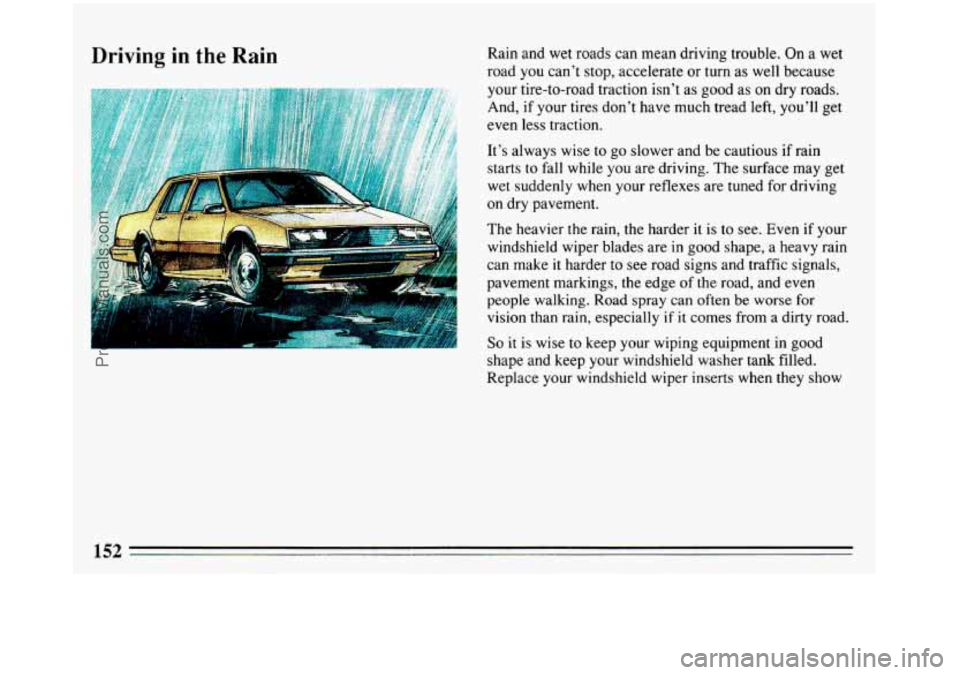
Driving in the Rain Rain and wet roads can mean driving trouble. On a wet
road
you can’t stop, .accelerate or turn as well because
your tire-to-road traction isn’t as good as on dry roads.
And, if your tires don’t have much tread left, you’ll get
even less traction.
It’s always wise to go slower and be cautious if rain
starts
to fall while you are driving. The surface may get
wet suddenly when your reflexes are tuned for driving
on dry pavement.
The heavier the rain, the harder it is to see. Even if your
windshield wiper blades are in good shape, a heavy rain
can make
it harder to see road signs and traffic signals,
pavement markings, the edge of the road, and even
people walking. Road spray
can often be worse for
vision than rain, especially if it comes from a dirty road.
So it is wise to keep your wiping equipment in good
shape and keep your windshield washer tank filled.
Replace your windshield wiper inserts when
they show
1 L3
ProCarManuals.com
Page 156 of 308
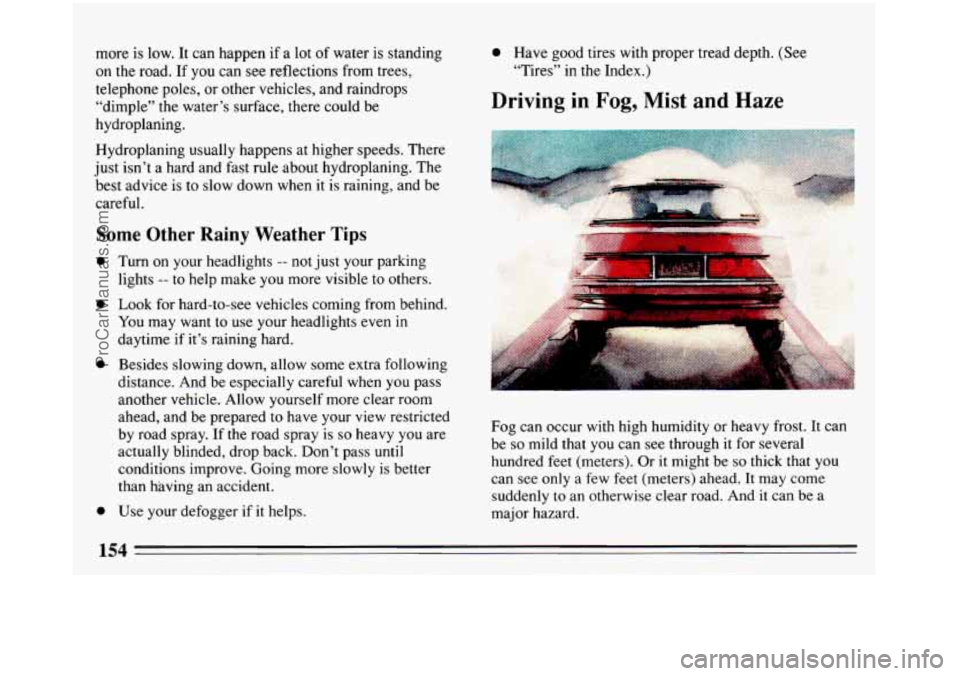
more is low. It can happen if a lot of water is standing
on the road. If you can see reflections from trees,
telephone poles, or other vehicles, and raindrops
“dimple” the water’s surface, there could be
hydroplaning.
Hydroplaning usually happens at higher speeds. There
just isn’t a hard and fast rule about hydroplaning. The
best advice is to slow down when it is raining, and be
careful.
Some Other Rainy Weather Tips
a
a
0
0
Turn on your headlights -- not just your parking
lights
-- to help make you more visible to others.
Look for hard-to-see vehicles coming from behind.
You may want
to use your headlights even in
daytime if it’s raining hard.
Besides slowing down, allow some extra following
distance. And be especially careful when
you pass
another vehicle. Allow yourself more clear room
ahead, and be prepared
to have your view restricted
by road spray. If the road spray is
so heavy you are
actually blinded, drop back. Don’t pass until
conditions improve. Going more slowly is better
than having an accident.
Use your defogger if it helps.
0 Have good tires with proper tread depth. (See
“Tires” in the Index.)
Driving in Fog, Mist and Haze
Fog can occur with high humidity or heavy frost. It can
be
so mild that you can see through it for several
hundred feet (meters).
Or it might be so thick that you
can see only a few feet (meters) ahead.
It may come
suddenly to an otherwise clear road. And
it can be a
maj or hazard.
154
ProCarManuals.com
Page 157 of 308

When you drive into a fog patch, your visibility will be
reduced quickly. The biggest dangers are striking the
vehicle ahead or being struck by the one behind. Try to
“read” the fog density down the road. If the vehicle
ahead starts to become less clear or, at night, if the
taillights are harder to see, the fog is probably
thickening. Slow down to give traffic behind
you a
chance to slow down. Everybody then has a better
chance to avoid hitting the vehicle ahead.
A patch of dense fog may extend only for a few feet
(meters) or for miles (kilometers); you can’t really tell
while you’re
in it. You can only treat the situation with
extreme care.
One common fog condition
-- sometimes called mist or
ground fog
-- can happen in weather that seems perfect,
especially at night or in the early morning in valley and
low, marshy areas.
You can be suddenly enveloped in
thick, wet haze that may even coat your windshield. You
can often spot these fog patches or mist layers with your
headlights. But sometimes they can be waiting for
you
as you come over a hill or dip into a shallow valley.
Start your windshield wipers and washer, to help clear
accumulated road dirt. Slow down carefully.
Tips on Driving in Fog
If you get caught in fog, turn your headlights on low
beam, even in daytime. You’ll see
-- and be seen --
better. Use your fog lights if your vehicle has them.
Don’t use your high beams. The light will bounce
off
the water droplets that make up fog and reflect back at
you.
Use your defogger. In high humidity, even a light
buildup of moisture on the inside of the glass will cut
down on your already limited visibility. Run your
windshield wipers and washer occasionally. Moisture
can build up on the outside glass, and what seems to be
fog may actually be moisture on the outside of your
windshield.
Treat dense fog as an emergency. Try to find
a place to
pull off the road. Of course
you want to respect
another’s property, but
you might need to put something
between
you and moving vehicles -- space, trees,
telephone poles, a private driveway, anything that
removes you from other traffic.
If visibility is near zero and
you must stop but are
unsure whether
you are away from the road, turn your
lights on, start your hazard warning flashers, and sound
155
ProCarManuals.com
Page 158 of 308
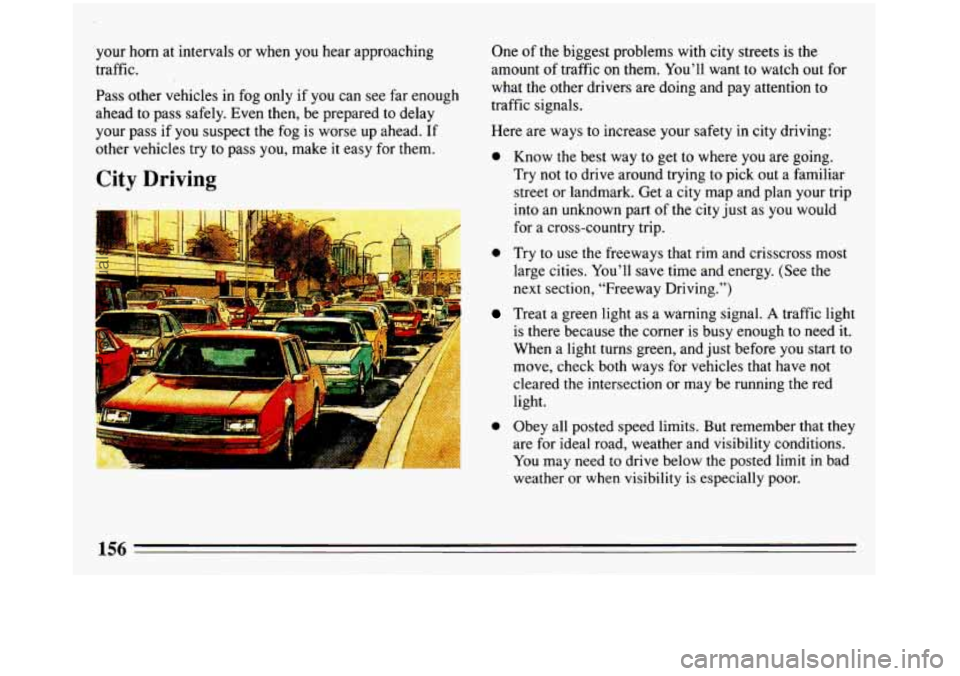
your horn at intervals or when you hear approaching
traffic.
Pass other vehicles in fog only if you can see far enough
ahead to pass safely. Even then, be prepared to delay
your pass
if you suspect the fog is worse up ahead. If
other vehicles try
to pass you, make it easy for them.
City Driving
One of the biggest problems with city streets is the
amount of traffic on them. You’ll want to watch out for
what the other drivers are doing and pay attention to
traffic signals.
Here are ways to increase your safety in city driving:
0 Know the best way to get to where you are going.
Try not to drive around trying to pick out a familiar
street or landmark. Get a city map and plan your trip
into an unknown part
of the city just as you would
for a cross-country trip.
large cities. You’ll save time and energy. (See the
next section, “Freeway Driving.”)
i 0 Try to use the freeways that rim and crisscross most
I Treat a green light as a warning signal. A traffic light
is there because the corner is busy enough
to need it.
When a light turns green, and
just before you start to
move, check both ways for vehicles that have not
cleared the intersection or may be running the red
light.
0 Obey all posted speed limits. But remember that they
are for ideal road, weather and visibility conditions.
You may need to drive below the posted limit in bad
weather or when visibility is especially poor.
156
ProCarManuals.com